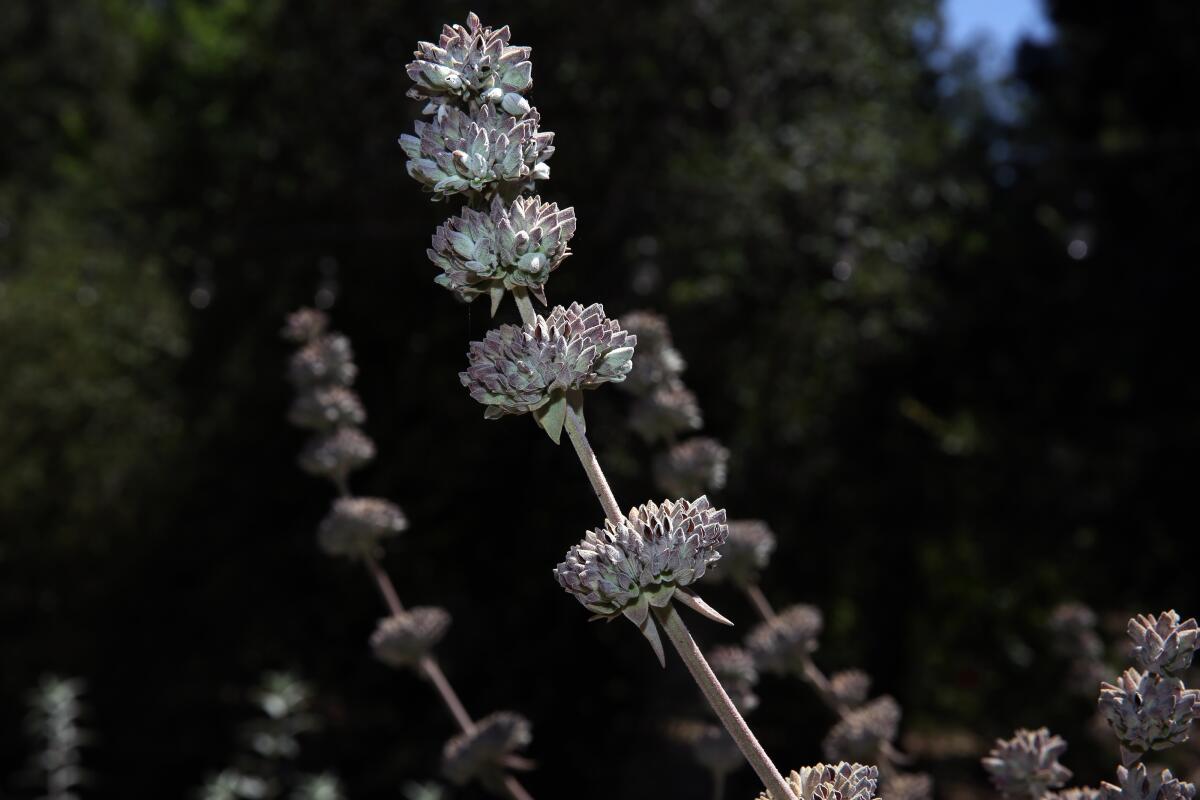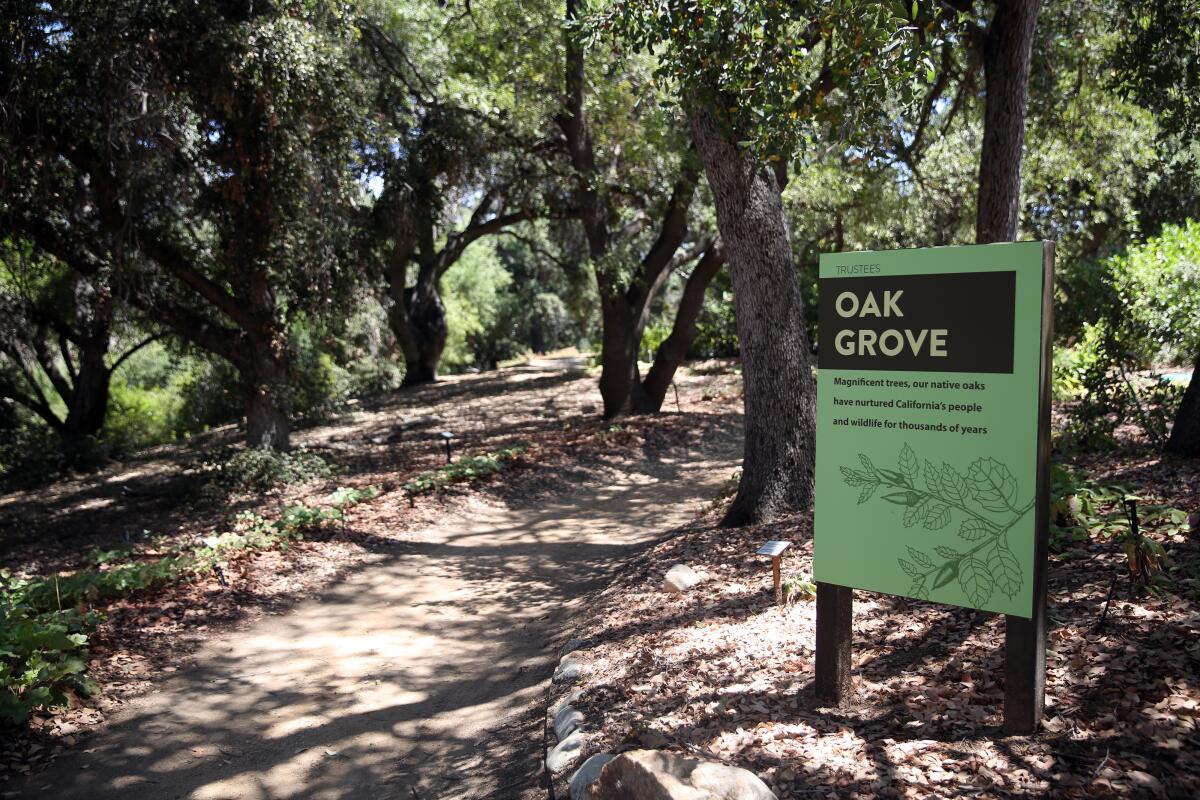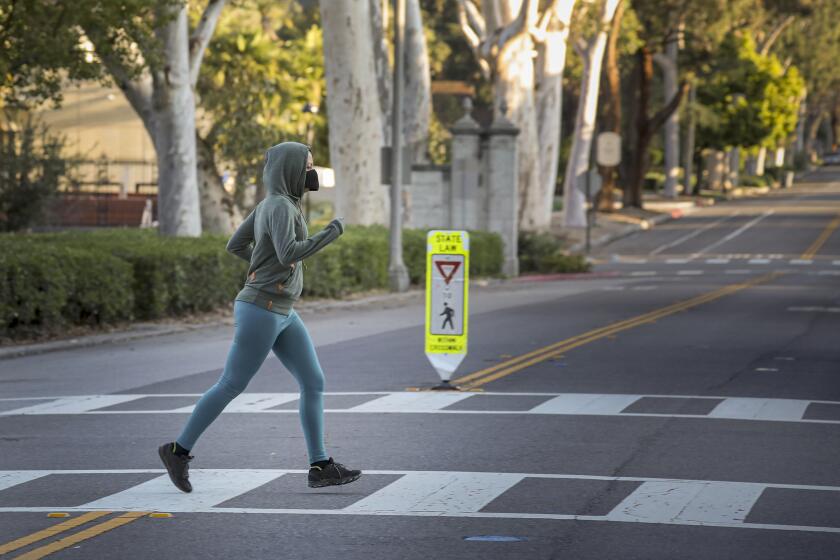California Botanic Garden is a feast (including ice cream!) for all our senses
California Botanic Garden is the new name for the state’s largest garden of California native plants, 86 acres near the Claremont Colleges of more than 1,200 native species, including redwoods and manzanitas, buckwheats, Joshua trees and about a jillion sages, many of which are blooming now.
Previously known as Rancho Santa Ana Botanic Garden, the public garden can get edged out of the spotlight by glitzier gardens with name recognition, such as the Huntington Library, Art Museum, and Botanical Gardens or Descanso Gardens.
If, however, you are among the many Californians considering a lawn-to-drought garden makeover but have been discouraged by the dowdy little native plants sold at nurseries, the California Botanic Garden is arguably the best place to see how beautiful, diverse and aromatic native plants become once they hit their prime.
Need another reason to visit? How about three: Coyote Mint Chip ice cream, Coastal Sage Yum ice cream and Cactus Cream ice cream, all made using native plants found at the garden. That trio of sweet treats is part of an upcoming virtual tasting and fundraiser for the garden, which like so many other public spaces finds itself struggling to regain its footing (and funding) in the midst of the pandemic.
“We think these gardens are an amazing platform to inspire people to bring California native plants into their gardens, their kitchens and beyond,” said David Bryant, the garden’s director of visitor experience.
Get The Wild newsletter.
The essential weekly guide to enjoying the outdoors in Southern California. Insider tips on the best of our beaches, trails, parks, deserts, forests and mountains.
You may occasionally receive promotional content from the Los Angeles Times.
The garden was scheduled to celebrate its new name with some big events at the end of March. Then, coronavirus struck and those plans were put on indefinite hold.
But the pandemic hasn’t stopped the garden from celebrating its uniquely California flavor.
The past two years, the garden hosted an event called Brew Wild, inviting SoCal breweries to create beers that incorporated native plants, and drew visitors to sample their creations. There can’t be any crowds this year but, inspired by the success of Brew Wild, the staff dreamed up some creative virtual events, such as Taste Wild, which provided samples of baked goods infused with native plants to 300 participants to pick up and eat at home for a virtual group tasting and recipe chat. (You can watch it on YouTube.)

The garden also has hosted Arrange Wild, providing 40 participants with bundles of native blooms and then drawing them together for a flower-arranging lesson online (also available on YouTube).
On July 30, participants will have another chance to sample more native plant cuisine with Freeze Wild: It involves taste-tasting those three native-plant-infused ice creams, as created by Claremont’s beloved Bert & Rocky’s Cream Co.
Roses and agapanthus are still in full bloom in the Huntington’s rose garden, just in time to welcome visitors when the gardens reopen on July 1, after being closed for more than three months due to coronavirus.
Bryant developed and tested the recipes for Coyote Mint Chip, Coastal Sage Yum and Cactus Cream in his home kitchen.
“These are the ones that are proven” delicious, he said. “But for every proven recipe I’ve had two to three failures. I tried Coyote Sagebrush ice cream once, and it tasted like turpentine. But I really love this. When I’m old and gray I want to open a native-plant ice cream shop, to incorporate my two most favorite things in the world.”
The Freeze Wild event will be limited to 300 people, to ensure the event doesn’t overuse the garden’s native plants. “Our ambition is to model sustainable use of our native plants,” Bryant said, and to encourage people to create their own garden of native plants so they can make these arrangements and recipes at home.
For $65 ($55 for members), participants get three pints of ice cream (one of each flavor) and an invitation to participate in the Zoom taste-testing and discussion about the recipes and how the plants themselves fit into the environment. People who pay $85 will get a VIP box with an ice cream scoop and cones.
Pricey perhaps, but the proceeds support the garden, which was started in 1927 by a prescient rancher named Susanna Bixby Bryant (no relation to David, who calls himself a “Texas” Bryant).

Susanna Bryant was worried about the way development was affecting native plants and habitats, so she set aside 200 acres of her Santa Ana Canyon ranch near Yorba Linda in Orange County for a native plant garden in memory of her father, John Bixby.
The gardens opened to the public in 1929 under a managing board and advice from many notable botanists of the day (including famed native plant conservationist Theodore Payne). When Susanna died unexpectedly from a stroke in 1946, the garden’s botanist, Philip Munz, a professor at the Claremont Colleges, became the director.
California university administrators discuss the on-campus experience that could await students this fall.
Munz and the trustees decided to move the gardens from the ranch to a site less remote and near a college, where it could be useful for research. The board purchased 54 acres near the Claremont Colleges and entered into an agreement with Pomona College for the perpetual use of 30-plus acres of college land for classes and research. The garden moved to its present site in 1951.
The Rancho Santa Ana name remained until recently, when the present board realized the garden needed a name that was easier to remember and better reflected its focus on native plants, David Bryant said. “We realized even people in Claremont didn’t know who we are.”
The college-research partnership is strong, with the largest seed bank dedicated to California native plants, conservation work to restore some 5,000 acres taken over by invasive species, and more than 100 PhD and master’s students graduated from the botany program.
Beautiful and ... delicious?
One of the garden’s most important goals, however, is to get people excited about growing native plants and incorporating them into their daily lives. And for this, Bryant is the perfect booster.
“People think that native foods are a novel experience,” he said, “but these flavors are really delicious and exciting.”
He points out black sage, for instance, and immediately waxes rhapsodic about its vanilla scent and the way its leaves enhance vanilla flavor. He uses food writer Melissa Clark’s famed ice cream recipe and wraps 20 or so black sage leaves in cheesecloth to steep in the egg-cream-sugar mixture overnight before removing the leaves and freezing the ice cream.
Meet the guys behind Venice label Born X Raised. They have a hit Rams collaboration — and designs on the world.
“It’s light and just wonderfully aromatic, without tasting like bath and body products,” he said. “For any dense, heavy meal like Thanksgiving, it’s the best dessert you can do.”
Want a more savory experience? Pluck a couple of California bay laurel leaves and stir those into a pasta dish for a few minutes, then remove and serve. The flavor is pungent and delicious, Bryant said, but don’t overdo it. “I’ve ruined more than one pasta dish by using too much,” he said. “We actually planted a California native laurel in the backyard because we love the flavor so much.”
Hummingbird sage, with its magenta flower spikes, and the delightful woolly bluecurls both make delicious iced tea. Just fill a quart-size Mason jar at least half full of leaves, add boiling water and let it steep overnight. “The flowers are so beautiful, if you serve the tea in a glass dispenser, you can leave the flowers in the tea and it looks great,” Bryant said.
Manzanita flowers make a lovely, deep magenta jelly, he said, no matter which variety you use. “I haven’t found a bad manzanita flower yet,” he said, “but in my experience, the more pink-tinged are the most delicious.” Take about 3 cups of flowers, cover with 1½ cups of water and boil. The whitish flowers will turn magenta as they break down. Then use the recipe on the back of a pectin package to create the jelly from the flower “juice.”
After a few months of closure, California Botanic Gardens opened with new truncated hours. Members can enter for free without reservations, but nonmembers must purchase their tickets online and reserve an entrance time to help maintain social distancing. Masks are required for visitors, and no tickets are sold at the entrance.
Finally, if you see plants you like, take a photo and jot down the name. The garden’s plant store is closed during the summer but will reopen in October, which is the best time for planting California native plants.
Sage Shortbread:
Naomi Fraga, the garden’s director of conservation programs, created a yummy shortbread recipe. (We haven’t tested it in the L.A. Times test kitchen, but we’re sharing it here.) It calls for 3 cups of white whole wheat flour, sifted; 1 cup powdered sugar; 1 teaspoon sea salt; 2 tablespoons chopped fresh sage (such as hummingbird sage); the zest from 2 lemons; and 1 cup of olive oil. Preheat oven to 325 degrees, whisk together everything but the oil, then stir in the oil until it is incorporated. Put the dough in a 9-by-9-inch baking dish, prick the surface with a fork, then bake for 45 minutes until the surface is firm to the touch and it’s lightly golden around the edges. Let the pan cool out of the oven for 20 minutes, slice into rectangles, and then let the cookies cool in the pan before removing them with a small spatula.
California Botanic Garden
Where: 1500 N. College Ave., Claremont
Hours: 8 a.m. to 1 p.m. and 3 to 8 p.m. Wednesdays through Sundays
Admission: Tickets must be purchased online. $10 for adults, $6 for seniors and students, $4 for children ages 3-12. Members and children under 3 enter free.
Info: calbg.org
More to Read
Sign up for The Wild
We’ll help you find the best places to hike, bike and run, as well as the perfect silent spots for meditation and yoga.
You may occasionally receive promotional content from the Los Angeles Times.













